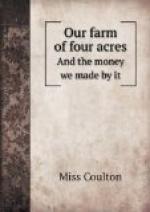At this, H., who had resided for a short time in a house where the bread was made at home, laughed, and said, “Really, Mr. L., you need not fear that we wish to put you to so much expense, and it is perhaps but fair that we should meet you half-way in the matter; so if you will find labor we will find materials: or reverse it, if you please.”
Mr. L. remembered that he had in some outhouse a quantity of “fire bricks,” and it was arranged that we should pay for the labor of constructing a three-peck oven. This occasioned on our part an outlay of $10, and this small sum was the source of considerable saving to us yearly.
We were more fortunate with our bread than with our butter-making, for Mary was a capital baker; our bread was always made from the best flour. We all liked it much better than bakers’ bread, and it was much more nourishing. Indeed, when I was once in Kent during “hopping,” and saw that the women who resided in the neighborhood always gave up half a day’s work weekly for the purpose of going home to bake, I used to wonder why they did not purchase their bread from a baker in the village. I was informed by one of them to whom I put the question, “Lord, ma’am, we could not work on bakers’ bread, we should be half-starved; it’s got no heart in it.”
To a small family, perhaps, the saving might not be considered an object, but any one who has for a few months been accustomed to eat home-made bread, would be sorry to have recourse to the baker’s; the loaves purchased are usually spongy the first day, and dry and harsh the second. It is not only that other ingredients than flour, yeast, and water are mixed in the dough, but it is seldom sufficiently baked; bread well made at home and baked in a brick oven for a proper time, is as good at the end of a week as it is the second day.
I have heard several persons say, “I should like home-made bread if it were baked every day, but I don’t like eating stale bread four or five days out of the seven.” If they stayed with us a day or two, they became convinced that bread which had been made three or four days did not deserve the epithet of “stale.”
I will now proceed to show the reader how much flour was consumed in our household, consisting of thirteen persons.
We used to bake weekly twenty-eight pounds of flour, of the best quality; this produced forty-two pounds of bread. I will give in the most explicit manner I can directions for making it, which I imagine any servant will be able to comprehend:
Place in a large pan twenty-eight pounds of flour; make a hole with the hand in the centre of it like a large basin, into which strain a pint of yeast from the brewer’s; this must be tasted, and if too bitter a little flour sprinkled in it, and then strained directly; then pour in two quarts of water, of the temperature of 100’, that is, what is called blood-heat, and stir the flour round from the bottom of the hole you have formed with the hand, till that part of the flour is quite thick and well mixed, though all the rest must remain unwetted; then sprinkle a little flour over the moist part, and cover with a cloth: this is called “sponge,” and must be left half an hour to rise.




